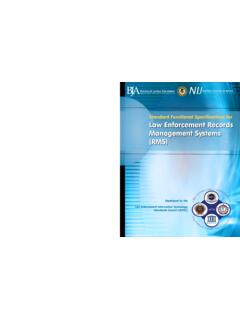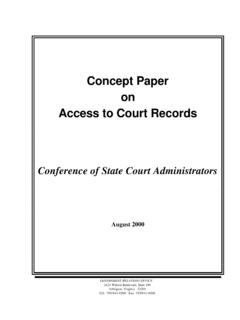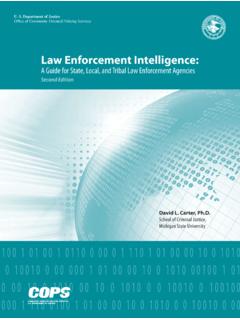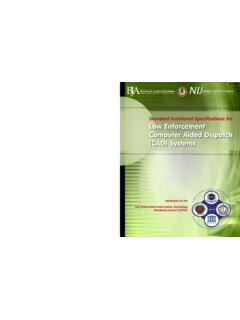Transcription of Standard Functional Specifications for Law Enforcement ...
1 Law Enforcement Computer Aided Dispatch (CAD) SystemsStandard Functional Specifications for Developed by the Law Enforcement Information Technology standards Council (LEITSC)Bureau of Justice AssistanceOffice of Justice Programs Department of JusticeNational Institute of JusticeThe Research, Development, and Evaluation Agency of the Department of JusticeNIJ Standard Functional Specifications for Law Enforcement Computer Aided Dispatch (CAD) Systems Law Enforcement Computer Aided Dispatch (CAD) SystemsStandard Functional Specifications for Developed by the Law Enforcement Information Technology standards Council (LEITSC) Standard Functional Specifications for Law Enforcement Computer Aided Dispatch (CAD) SystemsThis document was prepared with the guidance, leadership, and funding of the Bureau of Justice Assistance, Office of Justice Programs, Department of Justice, in collaboration with the Law Enforcement Information Technology standards Council.
2 This project was supported by Grant No. 2003-MU-BX-0068, awarded by the Bureau of Justice Assistance. Standard Functional Specifications for Law Enforcement Computer Aided Dispatch (CAD) Systems LEITSC GovernanceLarry Boyd, ChairmanChief of PoliceIrving (TX) Police DepartmentPolice Executive Research Forum (PERF)Joe AkersLEITSC Staff LiaisonNational Organization of Black Law Enforcement Executives (NOBLE)Terry ChowanecLEITSC Staff LiaisonPERFTed Kamatchus, Vice ChairSheriffMarshall County (IA) Sheriff s OfficeNational Sheriffs Association (NSA) Mark MarshallChief of PoliceSmithfield (VA) Police DepartmentInternational Association of Chiefs of Police(IACP) Morris Postal Service (Retired)NOBLE Heather RuzbasanLEITSC Project ManagerG.
3 Matthew SnyderLEITSC Staff LiaisonIACPFred WilsonLEITSC Staff Liaison NSALEITSC Functional standards CommitteeJoe CassaBureau CommanderWheat Ridge (CO) Police Department Mitchell Ray Davis, IIIC hief of PoliceDixmoor (IL) Police DepartmentDebbie FoxInformation Technology AdministratorLouisville (KY) Metro Police Department Michael HaslipChief of PoliceCity of Blaine (WA) Police DepartmentLinda HillConsultantIJIS Institute J. B. HopkinsDivision Commander/Jail AdministratorStory County (IA) Sheriff s OfficeDina JonesCAD ManagerStory County (IA) Sheriff s Office Bruce KellingBask Enterprises, LLCM anaging Principal Daniel MurrayIT Management Section CommanderArlington County (VA) Police Department Acknowledgements v Standard Functional Specifications for Law Enforcement Computer Aided Dispatch (CAD) SystemsBeverly MuseTechnology ManagerCity of Chattanooga (TN) Morris RobersonPostal Inspector (Retired) Postal Service Jim SlaterChief Information OfficerMassachusetts Executive Office of Public SafetyMark SteigemeierVice PresidentMotorola Darrell TrueIT AdministratorWrentham (MA) Police DepartmentGary VestChief of PolicePowell (OH)
4 Police Department Paul WormeliExecutive DirectorIJIS InstituteAdvisors and Other Program ContactsWilliam Cade, , 911 Services and Communications Operations CenterAssociation of Public Safety Communications Officials Joe EsteyChief of PoliceHartford (VT) Police DepartmentFormer LEITSC Governance Member IACPJoe HeapsCommunications Technology Portfolio ManagerNational Institute of JusticeOffice of Justice Department of Justice Dustin KooncePolicy AdvisorBureau of Justice AssistanceOffice of Justice Department of JusticeJ. Patrick McCrearyAssociate Deputy DirectorBureau of Justice AssistanceOffice of Justice Department of Justice Harlin McEwenChief of Police (Retired)Ithaca (NY) Police Department David Park PoliceIACPJ ennifer ZeunikFormer LEITSC Project Manager (2002 2005)IACPP roject ManagerHeather RuzbasanLEITSCI nternational Association of Chiefs of Police515 North Washington StreetAlexandria, VA 22314(703) 836-6767, ext.
5 Thanks to Our document is the result of an extraordinary collaboration between many justice practitioners and industry experts. Thank you all for your commitment, time, energy, and Institute Standard Functional Specifications for Law Enforcement Computer Aided Dispatch (CAD) Systems vTable of ContentsAcknowledgements ..iiiTable of Contents ..vExecutive Summary: CAD ..viiBusiness Function: Law Enforcement Dispatch .. Description: .. Use Case Diagram .. Use Case specification : Call Taking .. Use Case specification : Dispatch Decision Support .. Use Case specification : BOLO .. Use Case specification : Dispatch Units .. Use Case specification : Unit Status Management .. Use Case specification : Call Management .. Use Case specification : Supplemental Resources Use Case specification : Call Function: CAD System Administration.
6 Description: .. Use Case Diagram .. Use Case specification : Geofile Maintenance .. Use Case specification : Security .. Use Case specification : Use Case specification : Configuration .. Use Case specification : Table Maintenance .. Use Case specification : Communication Center Use Case specification : CAD Function: Support Description: .. Use Case Diagram .. Use Case specification : BOLO .. Use Case specification : Emergency Operations Center ..22 Business Function: Call Management and Management Reporting .. Description: .. Use Case Diagram .. Use Case specification : Dispatch Supervisor Use Case specification : CAD Management Reporting .. Use Case specification : Training and Testing ..24v Standard Functional Specifications for Law Enforcement Computer Aided Dispatch (CAD) SystemsBusiness Function: Interfaces.
7 Description: .. Use Case Diagram .. Use Case specification : Primary .. Use Case specification : Additional Interfaces .. Use Case specification : Locational Systems Interfaces .. Use Case specification : Administration Interfaces .. Use Case specification : Communications Interfaces .. Use Case specification : Public Awareness Messaging .. Use Case specification : Emergency Operations Additional Business Functions ..29 Conclusion ..31 Properties: Activity ..A:1 Properties: Actor ..A:7 Properties: Business Function ..A:11 Properties: State ..A:13 Properties: Use Case ..A:15 Standard Functional Specifications for Law Enforcement Computer Aided Dispatch (CAD) Systems v HistoryThe Law Enforcement Information Technology standards Council (LEITSC) was created in 2002 with funding (Grant Number 2002-LD-BX-0002) from the Department of Justice, Bureau of Justice Assistance and continued in 2003 with funding (Grant Number 2003-MU-BX-0068) through a collaborative effort between the Bureau of Justice Assistance and the National Institute of Justice.
8 LEITSC is currently funded under the Bureau of Justice Assistance (Grant Number 2003-MU-BX-0068) and continues to work in cooperation with the National Institute of Justice. LEITSC brings together representatives from the International Association of Chiefs of Police (IACP), National Sheriffs Association (NSA), National Organization of Black Law Enforcement Executives (NOBLE), and Police Executive Research Forum (PERF) to address law Enforcement information technology standards issues. The mission of the group is to foster the growth of strategic planning and implementation of integrated justice systems through the development and implementation of information technology 2003, LEITSC identified the need for a national Standard for computer aided dispatch (CAD) Functional Specifications .
9 They believed that the Standard would accomplish the following goals:Provide a starting point for law Enforcement agencies to use when developing CAD requests for proposal (RFP);Level the playing field when working with vendors; and Promote system interoperability (for example, CAD to CAD). With these goals in mind, the LEITSC Functional standards Committee, composed of law Enforcement practitioners and industry experts from around the country, was appointed to develop the Standard Functional Specifications for Law Enforcement CAD Systems. The baseline document was developed from common elements found in requests for proposals, technical documentation, and other CAD-related research. The document was then validated by the group using a modeling tool.
10 Once developed and validated, the Specifications were vetted through the law Enforcement community via each of the participating associations, as well as through other stakeholder communities in an effort to gain input from a number of different perspectives. National Initiatives: Law Enforcement Information Sharing Program (LEISP), Law Enforcement National Data Exchange (N-DEx), and Law Enforcement Regional Data Exchange (R-DEx)As law Enforcement agencies move toward the procurement of computer aided dispatch (CAD) and law Enforcement records management systems (RMS), it is vital to recognize and consider the Law Enforcement Information Sharing Program (LEISP) developed by the Department of Justice (DOJ). The LEISP is designed to promote information sharing among all levels of the law Enforcement community and to guide the investment of resources in information systems that will further this goal.












